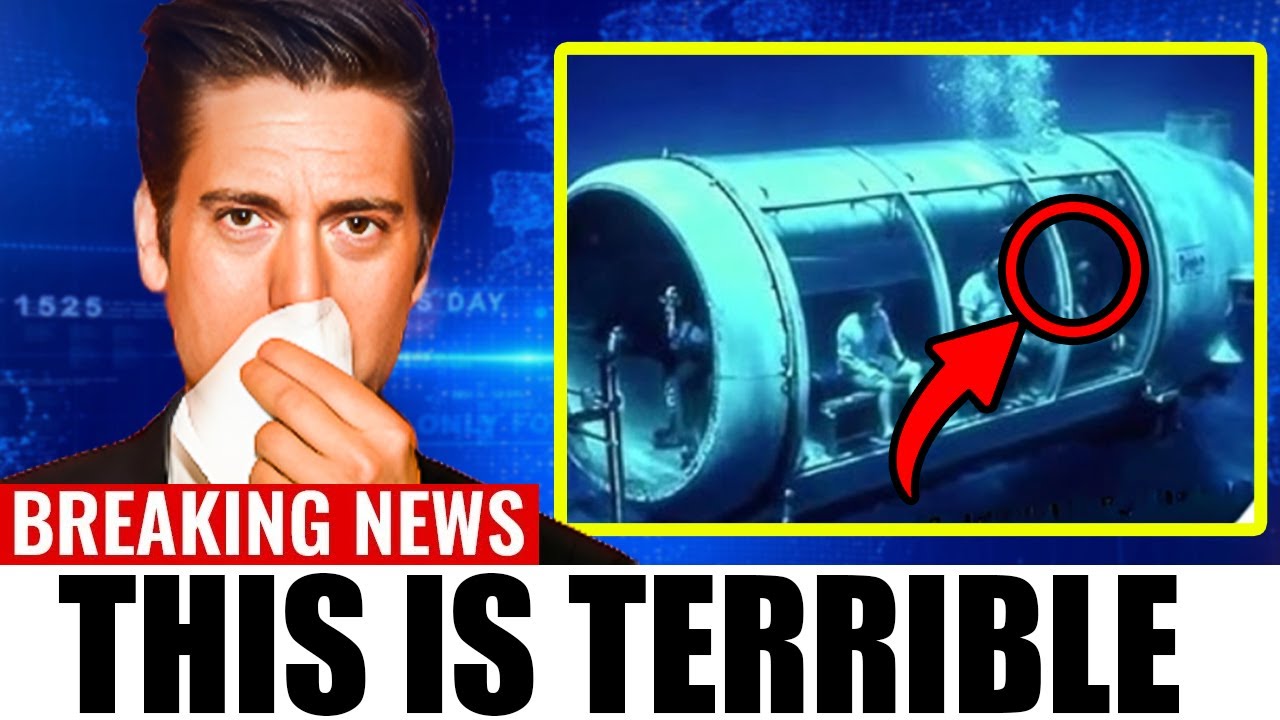The Ocean’s Darkest Secret UNRAVELED: The Titan Sub Disaster Will Leave You Speechless!
Imagine descending 12,000 feet into the abyss, chasing the Titanic’s ghostly remains… only for everything to go HORRIBLY wrong. The truth behind the Titan submersible implosion is finally out, and it’s more shocking than anyone could’ve imagined. What did the crew know in their final moments? And what chilling mistakes sealed their fate? 💔🌊 Click to uncover the heartbreaking details that will change how you see deep-sea exploration forever.

On June 18, 2023, the world watched in horror as the Titan submersible, operated by OceanGate, vanished during a dive to the Titanic wreck in the North Atlantic. Carrying five passengers, including OceanGate’s CEO Stockton Rush, the submersible was on a mission to explore one of history’s most iconic shipwrecks, lying 12,500 feet below the ocean’s surface. What began as a high-stakes adventure ended in a catastrophic implosion, claiming the lives of all aboard and sparking global fascination, grief, and outrage. Recent investigations, particularly the U.S. Coast Guard’s 2025 report, have revealed a chilling truth: this disaster was not a random stroke of bad luck but a preventable tragedy rooted in negligence, flawed design, and a toxic corporate culture. This article delves into the harrowing details of the Titan submersible disaster, uncovering the mistakes, ignored warnings, and systemic failures that led to one of the most shocking maritime incidents in modern history.
The Titan Submersible: A Bold but Flawed Vision
The Titan, originally named Cyclops 2, was OceanGate’s ambitious attempt to revolutionize deep-sea tourism. Unlike traditional submersibles, which typically use robust titanium hulls shaped in spheres to evenly distribute immense deep-sea pressure, the Titan featured a unique carbon-fiber and titanium composite hull. This design, spearheaded by OceanGate’s founder Stockton Rush, aimed to reduce weight and transportation costs while maintaining the ability to dive to depths of 4,000 meters. The submersible was marketed as a pioneering vessel, capable of ferrying wealthy clients—paying up to $250,000 per seat—to the Titanic wreck for a once-in-a-lifetime experience. Since 2021, OceanGate had conducted several successful dives to the Titanic, but beneath the surface of these achievements lay a troubling reality.
The choice of carbon fiber for the hull was controversial from the start. While carbon fiber is lauded for its strength and lightweight properties in applications like aerospace, its performance under extreme external pressure—such as the 6,500 psi experienced at Titanic depths—was untested in deep-sea submersibles. Experts warned that carbon fiber was prone to delamination, where layers of the material separate under stress, compromising structural integrity. Despite these concerns, Rush pressed forward, dismissing industry standards and regulatory oversight as barriers to innovation. The Titan was never certified by a ship classification society, a standard practice in the submersible industry to ensure safety. Instead, OceanGate relied on internal evaluations and marketed the submersible as meeting or exceeding industry standards, a claim later deemed misleading by investigators.
A History of Red Flags
Long before the fatal dive, the Titan’s development was marred by warning signs. In 2018, David Lochridge, OceanGate’s former director of marine operations, raised alarms about the submersible’s safety. Lochridge, who was not an engineer, criticized the lack of rigorous testing and third-party oversight, arguing that the hull’s integrity was questionable. OceanGate responded by suing Lochridge for breaching confidentiality, while he countersued, claiming wrongful termination as a whistleblower. The dispute was settled out of court, but Lochridge’s concerns were echoed by others. That same year, the Marine Technology Society drafted a letter signed by 38 industry experts, urging Rush to have the Titan certified. Rush dismissed the letter, reportedly saying he would “buy a congressman” to evade regulatory scrutiny.
Testing revealed further issues. In 2020, the original carbon-fiber hull showed signs of cyclic fatigue after dives to its maximum intended depth, leading to its replacement in 2021. Scale models of the hull imploded during tests at the University of Washington’s Applied Physics Laboratory, highlighting the material’s limitations under deep-sea conditions. Rush allegedly purchased discounted carbon fiber from Boeing—material past its shelf life for aerospace use—though Boeing later denied any record of the transaction. These red flags were compounded by operational missteps. In 2022, during a Titanic dive, the Titan became entangled in the wreck’s debris, narrowly avoiding disaster due to the absence of a risk mitigation plan. Passengers on earlier dives reported hearing loud bangs, later identified as delamination in the hull, a precursor to its eventual failure.
The Fatal Dive: June 18, 2023
The Titan’s final voyage began on the morning of June 18, 2023, from the support vessel Polar Prince, approximately 435 miles off the coast of Newfoundland, Canada. Aboard were Stockton Rush, piloting the submersible; Paul-Henri Nargeolet, a French deep-sea explorer known as “Mr. Titanic”; British adventurer Hamish Harding; and Pakistani-British businessman Shahzada Dawood and his 19-year-old son Suleman. The dive proceeded normally for the first 90 minutes, with the submersible communicating via text messages with the Polar Prince. At 10:47 a.m., as the Titan approached the seabed at a depth of 10,978 feet, it released ballast weights to adjust buoyancy—a routine procedure. Six seconds later, it transmitted its final location ping. Then, silence.
On the Polar Prince, OceanGate employees heard a loud “bang” from the ocean’s surface, later identified as the sound of the Titan’s implosion. The submersible’s carbon-fiber hull had succumbed to the immense pressure—4,930 pounds per square inch—collapsing inward in milliseconds. The U.S. Coast Guard’s 2025 report confirmed that the implosion was instantaneous, killing all five occupants before they could register the event. Debris, including clothing, business cards, and Titanic-themed stickers, was later recovered 1,600 feet from the Titanic’s bow, painting a grim picture of the vessel’s destruction.
The Investigation: A Damning Portrait
The U.S. Coast Guard’s Marine Board of Investigation, which released its final report in August 2025, painted a scathing picture of OceanGate’s operations. The report identified multiple contributing factors to the disaster, including inadequate design, lack of certification, poor maintenance, and a “toxic workplace culture” that silenced dissent. Stockton Rush, who served as CEO, safety officer, and lead engineer, was found to have consolidated power to the point of eliminating checks and balances. Employees described a team of young, inexperienced engineers ill-equipped to handle the complexities of deep-sea submersible design. One former director likened the Titan to a “high school project.”
OceanGate’s cost-cutting measures exacerbated the risks. In 2023, the Titan was stored outdoors during the Canadian winter, exposing the hull to temperature fluctuations that likely weakened its integrity. The company also reclassified passengers as “mission specialists” to bypass regulations for small passenger vessels, falsely claiming the Titan was an oceanic research vessel. Rush ignored warnings from industry experts, including renowned oceanographer Don Walsh and Titanic expert Rob McCallum, who refused to endorse OceanGate’s operations. The report concluded that Rush’s negligence could have warranted criminal charges had he survived.
The Human Cost and Public Reaction
The Titan disaster claimed the lives of five individuals, each with their own legacy. Paul-Henri Nargeolet, a veteran of 37 Titanic dives, was a respected figure in deep-sea exploration. Hamish Harding was a celebrated adventurer, while Shahzada and Suleman Dawood represented a prominent Pakistani family. The loss of 19-year-old Suleman was particularly heart-wrenching, with his mother, Christine Dawood, later denying claims that he was coerced into the dive. The Nargeolet family filed a $50 million lawsuit against OceanGate, alleging gross negligence and claiming the crew experienced “terror and mental anguish” as the hull began to fail—though simulations suggest the implosion was too rapid for the passengers to have been aware of their fate.
The disaster captivated global attention, sparking a media frenzy and “disaster tourism” as the Logitech F710 game controller used to steer the Titan sold out on Amazon. Social media platforms buzzed with memes and conspiracy theories, which media psychology expert Pamela Rutledge criticized as displaying a lack of empathy. The tragedy also drew comparisons to the Titanic itself, with oceanographer Peter Girguis noting the irony of hubris leading to catastrophe near the site of another infamous maritime disaster.
Lessons and the Future of Deep-Sea Exploration
The U.S. Coast Guard issued 14 safety recommendations to prevent future tragedies, including revoking exemptions for submersibles posing as research vessels and requiring stricter certification standards. The disaster has prompted calls for tighter regulation of the private deep-sea exploration industry, which remains largely ungoverned. Meanwhile, the allure of the Titanic persists. In 2024, a Georgia-based company announced plans to visit the wreck using remotely operated vehicles, and Ohio billionaire Larry Connor revealed intentions for a 2026 dive in a certified two-person submersible to restore confidence in the industry.
The Titan submersible disaster serves as a stark reminder of the dangers of unchecked ambition and the importance of rigorous safety protocols. The ocean’s depths are unforgiving, and the hubris of Stockton Rush—coupled with OceanGate’s systemic failures—turned a bold vision into a preventable tragedy. As the world continues to explore the abyss, the lessons of the Titan must guide future endeavors to ensure that innovation does not come at the cost of human lives.





